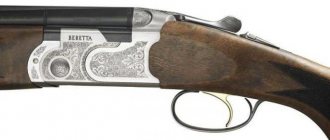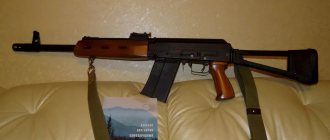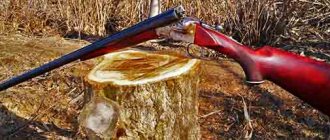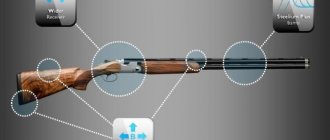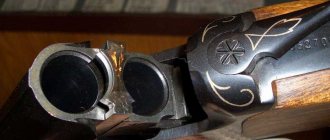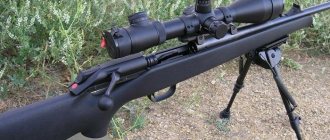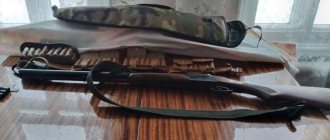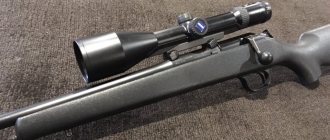Optimum. Double-barreled shotgun Blaser F16
Since its introduction to the market in 2004, the Blaser F3 has earned a good reputation, especially among sporting shooters. Then the Blaser engineers developed a completely new concept for the gun: the F3 had a trigger safety, a newly designed firing mechanism, good balance and a low height of the block, approximately 60 mm - despite being locked with under-barrel hooks, as well as a replaceable locking block that increases service life guns. The director of Blaser described the trigger mechanism as “the smoothest and best trigger.”
Blaser F3 double-barreled shotgun with open bolt
Due to the modular design of the barrels, the F3 model is a gun system itself, whose modularity also means higher manufacturing costs. The relatively high cost is also due to the labor-intensive heat strengthening technology: parts with high hardness must have precise dimensions. The lock with horizontal trigger guides also increased the price further. The F16 shotgun should no longer be included in this price class, associated with relatively high manufacturing costs. The requirements stated: we are designing a gun for hunting and sporting in the price class of 3000 euros. So it became clear that the modular design of the barrels would have to be abandoned. The F16 concept, at the same time, did not provide for any compromises in terms of the property called Pointability. There is no literal translation into Russian for it: in principle, it refers to the ability of a gun to hit targets as if automatically - if the shooter performs the correct butt and leash. The center of gravity must thus lie between the hands, the distribution of masses in the direction of the muzzle and butt plate must be such that the mentioned Pointability is achieved.
Double-barreled shotguns 12 gauge Blaser F16 Sporting (top) and Blaser F16 Game
The F16 - the name refers to the year of manufacture - has two variants. Game is a gun aimed at hunters who visit the shooting range from time to time. It provides a choice between barrel blocks with a length of 710 mm and 760 mm. The Sporting variant is intended for skeet shooters who would like to have a really good shotgun for sport, but for whom 5,000 euros or more is too high a sum for such a hobby. The Sporting version is available with 760 mm and 810 mm barrel blocks. Both options feature a bar that tapers from 9mm to 7.5mm. Sporting received a red luminous front sight, Game received a round nickel silver front sight. Both variants also differ in the lettering on the last: the Game has a silver F16 logo, while the Sporting model has a red one.
The F16 Game 3 mm round nickel silver front sight is mounted on a bar that tapers towards the muzzle of the barrel.
The block is made as a monocoque. It is milled from a single piece and rounded at the bottom, which in professional jargon is called a Semi-Round Body. The surface is subjected to chemical nickel plating followed by vacuum deposition. The result is a Gun Metal Gray finish. The F16 is equipped with a single trigger that is operated mechanically. This gives a very important advantage when hunting compared to switching under the influence of recoil force: if the primer misfires due to the fault of the primer, the shooter can nevertheless quickly fire a second shot, because the fox or duck is still within range. With the aforementioned switching due to the recoil of the weapon, everything is different.
The Blaser F16 trigger in the Sporting version is adjustable in length. In front of the hook there is a lever for switching the sequence of shots from the barrels
Like the F3, the F16 is equipped with an IBS (Inertial-Block-System) safety system to prevent double shots. Thanks to this, it became possible to increase the trigger force to 1650. Also familiar from F3 is the so-called Ejection-Ball-System (EBS), in which the ejectors are cocked after firing a shot when the gun is opened. When the cartridges are ejected, the springs are released again, which results in very high durability and at the same time a stable extraction force. Athletes appreciate this: resistance when closing the gun is always an equally unfavorable property for the concentration phase before the shot. The F16 does not have axial triggers that act directly on the firing pins. As usual, the triggers are designed with a low pivot point. This is the reason for the slightly longer time for the primer to break compared to the F3 gun. Switching the order of shots is carried out not by the usual safety slider on the neck of the butt, but by a lever in front of the trigger. Thus, the shooter, if necessary, can quickly switch with his index finger. The reverse sequence, that is, upper - lower, occurs, however, infrequently, but in sporting and in some cases in hunting it still makes sense.
The Blaser F16 shotgun is equipped with the Blaser EBS system. This means that the resistance when closing the gun is always very low, which has a beneficial effect on the shooter's concentration phase before firing.
The F16 is locked using underbarrel hooks and a fork-shaped wedge in the frame. When firing, the forces that usually arise are perceived by the hinge axis with a diameter of as much as 14 mm. Not only this powerful hinge axis is responsible for the special strength of the locking unit, but also the under-barrel hook, which fits into the cutout of the pad cushion. The barrels are connected to each other, as well as the bar with the barrels, soldered with hard silver solder. The bores of the barrels are protected with a hard chrome coating, and the barrels themselves are rigidly soldered into the breech with a hook. This is a reliable manufacturing method, which at the same time is also cheaper than the technology used in F3.
Blaser F16 detached handguard: the lock and counter support are visible, as well as the balancing weight on the barrel block. The ejectors are not located on the forend
Both barrels are chambered in 12/76 caliber. The transition cone has a length of 77 mm, the diameter of the cylindrical part of the barrel bore is 18.6 mm. The barrel block is shot blasted with ceramic balls and then oxidized. And here there is a difference with the F3, whose barrels are subjected to ion-plasma nitriding. The F16 comes with Blaser 1/4, 1/2 and 3/4 choke tubes complete with a choke wrench. Additional Blaser choke tubes from cylinder to full choke are also available for an additional price, as are Briley Spectrum extended chokes ranging from Skeet to 3/4, so the shooter has everything he needs at his disposal.
The Blaser F16 Sporting sports shotgun has a red luminous front sight with a diameter of 3 mm, the rib is the same as that of the F16 Game
Production F16 shotguns are supplied with a stock made of grade 2 wood. The Game model stock has a greater drop of 38 mm at the front of the comb and 56 mm at the buttplate. Thanks to this, it provides a stock that is familiar to many hunters. For the Sporting model these values are 38 mm and 50 mm. The length of the butt with the butt plate is 375 mm. The neck of the butt, as well as the fore-end, have a “fish scale” type notch for better grip. The forend is separated by a latch recessed into its nose. In the stock - in addition to the different lowering - there is another difference between the F16 Game and F16 Sporting. The Sporting model has a “balancer” in the buttstock, with which the shooter can change the balance of his gun. He can do this additionally on the barrel, where a device is provided for installing the corresponding loads. Weights mounted on the barrel block are, of course, not included in the base price.
The new Blaser F16 model is a beautiful, elegant gun with a classic appearance. Already from the first use it becomes clear that Blaser has succeeded in creating a lightweight, comfortable hunting rifle with excellent grip, which can be taken for duck or hare hunting.
Walter Schulz, translation by Ilya Shaidurov
Blaser F16: first acquaintance
The appearance of a truly new model of hunting or sporting weapon is an extraordinary phenomenon. Sometimes some companies pass off as a new product an already existing model of a weapon that has undergone only a small tuning: a different color of the block, a slightly changed shape of the fore-end or sighting bar - and voila, a new model of the gun. Is it possible to create a truly new model of gun in the first quarter of the 21st century? As it turned out, it is possible. The new model of the gun, created by our compatriot Sergei Vasilyevich Popikov at the Blaser company, became a real sensation. (This is far from the only successful work of Sergei Vasilyevich: over 23 years of work in the company, he implemented 72 (!) projects.)
The Blaser F16 shotgun was first presented at the British Shooting Show in Warwickshire (England) in mid-February 2016. The British feared that the Blaser company, which produces premium-segment hunting and sporting weapons, when releasing a mid-price shotgun model, like other weapons companies moving into a lower price segment, could sacrifice quality in order to meet the given cost price. But after seeing the gun and shooting from it, the reserved and prim Englishmen were delighted: the legendary German accuracy and thoroughness of assembly, the trigger with a force of 1600 g, perfect balance, low-profile block, the block and barrels are made of chrome-molybdenum-vanadium steel, high shooting comfort. Then, in March, this gun became a real sensation at the IWA show. The exhibition has just started, and top managers of the world's leading arms companies have already come to the Blaser stand and began to carefully study the F16. To be honest, in the ten years that I have been traveling to IWA as a correspondent for gun magazines, I have never seen anything like this. The presentation of the Blaser F16 shotgun in Russia took place at the Biserovo-Sporting Sports Complex on the eve of the opening of the “Weapons and Hunting” exhibition. (We must pay tribute to the fact that for several years in a row, they have been holding presentations of new models of weapons at stands and in shooting complexes, thereby giving dealers and representatives of specialized media the opportunity not only to hold weapons in their hands, but also to shoot from them.) Sergei Popikov presented the new product. When developing the F3 model, Sergei Vasilievich said, he was given the task of creating an absolutely unique gun for the Blaser company, the design of which would implement the maximum possible number of patent-protected solutions and the maximum possible modularity of the system. The task was completed, but due to the fact that the F3 model gun turned out to be very complex both in terms of production and in terms of maintenance (the gunsmiths had to be very highly qualified), in 2009 Sergei Vasilyevich decided to develop a new model of the gun 12 caliber with a vertical barrel arrangement, suitable for hunting and sports (unlike the F3 gun, which was created as a sport-hunting gun). The designer set himself the task of achieving the greatest possible cost reduction, but at the same time maintaining as much as possible the advantages highly appreciated by the shooters in the F3 model. For three years, in his free time from work, Sergei Popikov hatched the idea of a gun. In 2012, Sergei Vasilievich presented the proposed design solution for approval to the management of the Blaser company. After its approval, it was decided to make a prototype. Thus, work officially began on the creation of a new model of gun. But you should not think that the F16 is an ego clone of the F3. F16 is a completely new gun. The new model from the F3 shotgun uses only perfectly working ejectors, the reliability of which is recognized throughout the world. The design of the USM 146 is fundamentally different from the USM R'Z, if only in that it is a trigger system with springs inside the triggers, which was used in the TOZ-91 gun, designed by Sergei Vasilyevich at the Tula Arms Plant in 1991. And most importantly, an absolutely simple and reliable inertial-mechanical fuse against double shots: when fired, a huge pendulum rolls back and holds the disconnector in the rear position. This design solution is protected by a patent. Another feature of this model is that the weapon was originally designed with special emphasis on ease of use by hunters and shooters and maintenance by non-highly qualified gunsmiths. The design of the trigger, according to Sergei Popikov, is the simplest: two sears, an inertial disconnector and a mechanical translator for switching the shot order. The F16 is a very simple gun in design, yet it provides excellent reliability, beauty and cost. “We managed to solve the most important problem in modern conditions: we maintained the quality of the weapon as a whole, but at the same time reduced production costs by 45% (!), in particular due to the abandonment of plasma treatment of barrels and frames. Plasma treatment of the barrel accounted for 30% of the cost of the gun. The second important innovation is that we switched from using soft solders to hard solders. When soldering, the company uses a patented technology that eliminates the need to drive barrels,” says Sergei Popikov. The barrels are manufactured by Blaser, after which they are sent to Italy, where they are soldered. Despite the costs associated with transporting barrels to Italy and back, the cost of the finished product is reduced by 25-30% compared to if Blaser had implemented a similar technology at home. Soldering with hard silver-containing solder completely eliminates even the slightest possibility of barrel desoldering. As far as I know, in the entire history of the production of the F3 gun (and soft solder was used in its production) there were no more than 50 cases of barrel desoldering, and then only in the area of 30-40 mm under the forend. There was no such thing that the side rails were soldered along the entire length, as happens with sporting shotguns from famous Italian manufacturers. F16 barrels are absolutely identical in internal contour to F3 barrels. The Triplex bore profile is an implementation of John Moses Browning's idea 75 years ago. With old technologies, obtaining a stepped contour of the barrel bore was an extremely labor-intensive task, since it was necessary to shuffle the barrels; today’s technology allows for forging this contour directly on the machine and finishing it using diamond hones of a given profile. Channel processing accuracy +/- 0.02 mm. The bore is chrome-plated, the thickness of the chrome coating is 0.03 mm. The barrel bore diameter of 18.6 mm is optimal, according to experts, for both hunting and sport. The excessive enthusiasm of some weapon manufacturers for overboring in pursuit of imaginary advantages creates problems for those hunters and shooters who prefer or are sometimes forced to shoot cartridges with felt or felt wads. When firing from overbored barrels with such cartridges, the quality of the shot significantly suffers and, consequently, the combat deteriorates significantly. The Blaser company presented the F16 shotgun in two versions: hunting and sporting. Both options have a lot in common, but there are also some differences. For example, the sports modification has a red fiber optic front sight, an adjustable trigger, a red logo on the block, places for attaching barrel balancers, barrels 76 and 81 cm long; and the hunting version has a metal front sight, a non-adjustable trigger, a silver logo, no barrel balancers, barrels 71 and 76 cm long. The weight of the sports modification can be up to 3.8 kg, the hunting version - 3.1 kg. What both modifications have in common are excellent technical characteristics, the highest quality of materials and the legendary Blazer-like accuracy during assembly. The F16 is a great choice for everyone: for those who are just starting out and for those who have already reached a certain level of skill. “If in the first act there is a gun hanging on the wall, then in the third act it must go off.” These words about the law of drama are attributed to Anton Pavlovich Chekhov. Although in fact the phrase from Chekhov’s letter to Alexander Lazarev-Gruzinsky sounds somewhat different, I propose to leave it in a more familiar form, because it ideally suits the event being described. I have already mentioned that the presentation of the gun took place at the Biserovo-Sporting sports complex. After the first acquaintance with the weapon, guests were invited to two layouts, where the culmination of the presentation took place - test firing. Each gun was fired 500 times at a rapid pace. Sergei Popikov stood nearby, helping the not very experienced shooters and was absolutely calm about the integrity of the soldering of the barrels. (And here’s what a famous Italian gunsmith says: “After 50 targets, the gun must be allowed to cool down.”) By the way, it turned out that Sergei Vasilyevich himself is a good stand shooter. We shot with the NRG Flash Sporting cartridge with a 28 g load of shot. I can only assume that it ensures high shooting comfort. Apparently, this is a combination of all factors: the profile of the barrel bore with an elongated projectile entrance, Triplex drilling, low-profile block, the correct structure of the stock (none of the shooting participants complained that the comb of the butt hit the cheekbone), which reduces the impact of the recoil impulse on the shooter’s shoulder during the shot, and, of course, the cartridge. At times it even seemed as if the gun itself, separate from the shooter, was guaranteed to hit targets. In any case, our colleague from St. Petersburg, who took a smoothbore gun in her hands for the first time, hit five out of six targets! As a famous Russian shooter told me: “I don’t know a single person who wouldn’t like a Blaser stock.” F16 sales in Europe and the US reached truly incredible levels from April to September. Will this gun be sold just as successfully in Russia? The competitors in the same price niche of the new Blazer are serious and no less eminent in the segment of both hunting and sporting weapons. Most likely, potential buyers will be guided by considerations of reliability (here the F16 has a clear advantage: there is simply nothing to break), personal preferences and established stereotypes. I believe that it would be the right step on the part of the Blaser company management, together with dealers, to form a team of contract shooters with the F16 in Russia in order to actually convince Russian shooters of the true advantages of this gun model. The editors express gratitude for the opportunity to take part in the presentation of the Blaser F16 shotgun. Russian hunting magazine
Andrey Ugarov

